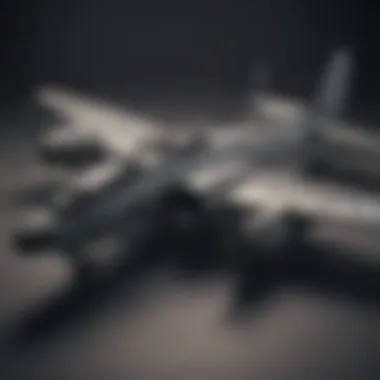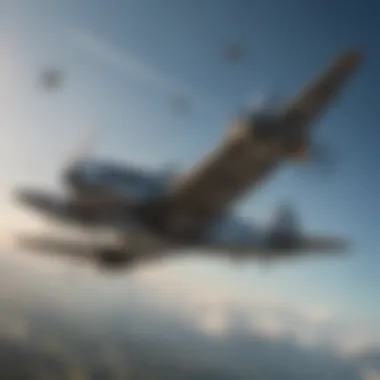The Evolution of WWII Aircraft: An In-Depth Analysis


Intro
World War II was a pivotal moment in aviation history. Aircraft development experienced rapid progress due to the demands of warfare. This article examines the fundamental transformations in aircraft technology during this period, key models deployed by various nations, their operational roles, and their long-term effects on military aviation. Understanding these elements provides insight into how aerial combat evolved and influenced the outcome of the war.
Technological Advancements
A central theme of this analysis is the technological advancements that shaped WWII aircraft. From the onset of the conflict, engineers looked to improve speed, maneuverability, and payload capacity.
Engine Development
One of the significant breakthroughs in aircraft technology was the advancement of aircraft engines. Aircraft transitioned from the older radial engines to more efficient inline and jet engines. The introduction of the Boeing B-29 Superfortress marked a move towards high-altitude bombers with improved fuel efficiency and range, which played a crucial role in air raids over Japan.
Aerodynamics
Aerodynamic design underwent substantial improvements. The use of streamlined fuselages and more efficient wing shapes increased performance and reduced drag. Fighters like the North American P-51 Mustang showcased these developments, allowing them to outpace many enemy counterparts.
Notable Aircraft Models
The war saw numerous iconic aircraft, each contributing uniquely to military strategies. These models became legends in their own right because of their performance and design.
The Supermarine Spitfire
The British Spitfire is infamous for its role in the Battle of Britain. Known for its agility and speed, it played a vital part in countering the Luftwaffe offensives. Its Rolls-Royce Merlin engine provided the necessary power, making it a formidable opponent in dogfights.
The Messerschmitt Bf
Germany's Bf 109 was another essential player. This versatile aircraft served in numerous roles, from fighter to ground attack. The continuous modifications throughout the war kept it at the forefront of aerial combat effectiveness.
The Lockheed P-38 Lightning
Unique for its twin-boom design, the P-38 played diverse roles as a heavy fighter and bomber interceptor. Its versatility in multiple theaters, especially in the Pacific, illustrated the strategic importance of adapting designs to operational needs.
Roles in Different Theaters of War
A complex interplay of tactics and technology defined the use of these aircraft in various contexts.
European Theater
In Europe, aircraft like the B-17 Flying Fortress conducted strategic bombing runs aimed at crippling German infrastructure. The use of long-range fighters helped protect bombers during missions.
Pacific Theater
In the Pacific, naval aviation took center stage. Japanese Zeroes, known for their agility, faced American aircraft with superior technology, leading to intense air battles. Aircraft carriers became the projectiles of war, signifying a shift from traditional land-based air operations.
Effective aerial combat often determined the success of ground forces, showcasing the necessity for specialized aerial strategies.
Ending
The aircraft of World War II were not mere instruments of war but symbols of technological progress and strategic thinking. Their evolution serves as a foundation for future developments in military aviation. The lessons learned during this period continue to influence aircraft design and combat strategy today, underlining the significance of this era in aviation history.


Prolusion to WWII Aircraft
The landscape of aerial warfare transformed radically during World War II, marking a pivotal moment in military history. Understanding the emergence and role of aircraft in this conflict is essential, as it illustrates how air power changed the nature of combat operations. Throughout World War II, air superiority became a critical factor influencing the outcomes of battles and the overall configuration of the war. Airplanes evolved rapidly, leading to enhanced tactical advantages and shaped strategies employed by both the Allies and Axis powers.
Importance of Air Power in World War
Air power was not merely an extension of land warfare but a whole new dimension of conflict. Aircraft enabled forces to gain significant advantages over enemies, improving reconnaissance capabilities and supporting troop movements. Instead of relying solely on ground and naval forces, military leadership recognized that the sky offered strategic insight and opportunities to engage the enemy effectively.
The successful implementation of air power altered traditional tactics. For example, countries that effectively integrated aircraft into their strategy often achieved significant victories early in the war. The devastation caused during aerial bombardments inevitably influenced combat plans and resource allocation. Hence, various nations dedicated substantial resources to expand their air fleets, resulting in a fierce race for innovation and dominance.
"The outcome of multiple campaigns hinged upon the ability to control the skies."
This emphasizes that the dawn of aerial bombardment heralded a shift that altered war methodologies fundamentally.
Preferably, the significant challenges faced in developing and deploying effective air strategies meant that those who grasped the necessity for air supremacy gained considerable ground. This included intercepting enemy aircraft, securing vital supply routes, and providing support to ground troops efficiently. Through aerial warfare, countries sought to disrupt enemy capabilities from above, leveraging newly developed technologies and tactics.
Overview of Aircraft Types
Understanding the diversity of aircraft used during World War II is key to grasping their roles in the conflict. The design and functionality of military aircraft ranged from the fast-moving interceptors to the heavy bombardiers capable of inflicting substantial damage. Recognizing the types and classifications of these aircraft provides insight into the multidimensional combat operations employed.
- Fighters: These aircraft focused primarily on engaging enemy aircraft, providing air support and maintaining air supremacy. Variants like the Supermarine Spitfire and the Messerschmitt Bf 109 became iconic for their performance in dogfights.
- Bombers: More substantial in size, bombers conducted strategic bombing missions to destroy key infrastructure. Notable examples include the Boeing B-17 Flying Fortress and the Avro Lancaster, responsible for delivering devastating strikes over enemy territories.
- Transport and Reconnaissance: Supporting the entire military framework, transport aircraft facilitated vital supply lines, while reconnaissance planes gathered essential intel to inform strategies. Aircraft like the Douglas C-47 Skytrain served widely in these roles, proving their immense operational value.
By categorizing these variations, one gains a comprehensive understanding of the enabling structure aviation offered in World War II operations, underscoring their importance well past the battlefield of the time.
Key Classes of WWII Aircraft
The classification of aircraft during World War II transcended mere terminology. It encapsulated their roles, functions, and strategic implications in aerial warfare. Understanding the diverse classes of WWII aircraft allows for an appreciation of the innovative approaches countries took to address the intricacies of modern combat.
Fighter Aircraft
Characteristics of Fighter Planes
Fighter planes were the backbone of air superiority. Their nimble designs allowed them to engage directly with enemy aircraft, thus playing a pivotal role in battle outcomes. Key characteristics include superior speed, advanced maneuverability, and heavy armament. This combination aimed to outmatch opponents in dogfights. The advantageous speed meant they could intercept bombers, which were critical for safeguarding ground forces.
Unique features like powerful engines and streamlined shapes provided fighters with both offensive capabilities and defensive reliability. These aspects made them a vital force, but their fuel consumption and pilot training demands posed challenges.
Notable Fighter Models
Several fighter aircraft stood out during the war. The Supermarine Spitfire is known for its elegant design and performance that excelled in the Battle of Britain. Its role was integral, as it turned the tide against Luftwaffe bombers, embodying both speed and agility.
On the other hand, the North American P-51 Mustang combined long-range capabilities with unmatched speed. This made it invaluable for ground support. Such unique features highlight the engineering achievements of the time, and they gave air forces decisive advantages in critical engagements. However, increasing the complexity of war strategies and engineering can stretch logistics thin.
Bomber Aircraft
Strategic Bombing Missions
Strategic bombing missions sought to undermine the enemy structurally and morally by targeting industrial resources and civilian centers. This approach shifted warfare from only direct engagement to broader strategic impacts. Bombers aimed to disrupt production lines and weaken the enemy's ability to sustain war efforts. The effectiveness of these missions prompted nations to heavily invest in bomber development.
Unique features of bombers, such as payload capacity and range, maximized their impact. However, the drawbacks included vulnerabilities to fighter interceptors, which required careful planning in aircraft deployment and escort missions, to ensure mission success.
Iconic Bomber Aircraft


Several bombers became iconic symbols of their respective air forces. The Boeing B-17 Flying Fortress was renowned for its durability and multiple defensive guns that protected against attacks during missions. Its various improvements over time allowed it to maintain relevancy amidst evolving aerial threats.
Alternatively, the Avro Lancaster is celebrated for its successful role in the bombing of Germany’s industrial heart. Its unique features enabled extensive payloads, assuring devastating strikes against carefully chosen targets. Each design had trade-offs between bomb capacity and defensive capabilities, affecting tactical outcomes in various theaters.
Transport and Reconnaissance Aircraft
Role of Transport Planes
Transport planes fulfilled crucial logistical functions. They facilitated troop movements, supplies, and material engagements critical for sustained military operations. Effective communication and resupply enabled forces to sustain extended engagements against strategically advantageous positions.
Key characteristics often included ample cargo capacity and robust structures for diverse environments. However, relatvely slower ascent and defenseless nature against enemy fighters could lead to high attrition rates. Addressing these limitations often influenced operational decisions.
Significance of Reconnaissance Missions
Reconnaissance missions offered intelligence vital for strategic decisions. Aircraft designed for such roles provided essential information about enemy positions and movements. Benefits were evident in campaigns where timely information attained by faster reconnaissance planes influenced the next tactical moves.
Unique features of these aircraft encompassed advanced photography capabilities and extended range. But the risks from enemy fire and losing aircraft in contested territories required careful strategy and protection. This field clarified the importance of evaluating risks in comprehensive military frameworks.
Technological Advancements in Aircraft Design
Technological advancements played a pivotal role in the evolution of aircraft during World War II. These innovations not only transformed the performance and capabilities of warplanes but also redefined aerial warfare itself. The significance of this progress lies in its influence on tactics, strategy, and the overall outcome of the conflict. By dissecting these advancements, one gains insight into how cutting-edge design and engineering helped determine the effectiveness of various military operations.
Innovation in Aerodynamics
Aerodynamics emerged as a primary focus in aircraft design during WWII. Enhanced aerodynamic profiles contributed to improved stability, speed, and maneuverability. Engineers sought to minimize drag and optimize lift, which factored into several critical developments. The introduction of features such as pointed noses, tapered wings, and NACA airfoils emphasized efficiency at various flight speeds.
Among the most notable innovations was the swept-wing design. This alteration enabled aircraft to maintain control at higher velocities, providing advantages during dogfights and bombing raids alike. For example, airplanes like the Messerschmitt Me 262 showcased how this innovation could translate directly into battlefield superiority.
Additionally, wind tunnel testing became essential in fine-tuning wings and fuselages, allowing for better flight characteristics before the aircraft entered production.
Materials and Manufacturing Techniques
The war also spurred significant advances in materials and manufacturing techniques. Previous WWII aircraft employed mainly wood and fabric, which limited combat effectiveness and longevity. The need for durable and efficient designs led to increased use of aluminum and, later, composite materials.
Metal fabrication allowed for stronger and lighter structures, which directly impacted weight-to-power ratios. Aircraft like the Boeing B-17 were increasingly constructed with robust metal airframes, enhancing their capabilities to carry weaponry and payloads into longer missions.
Manufacturing processes, focused on efficiency due to war-time exigencies, included assembly line methods. These techniques bolstered production rates, enabling nations to supply their forces more effectively. This rapid manufacturing ability made it possible to field massive fleets of combat aircraft.
Advances in materials led to improved mission efficiency and increased pilot survivability.
Collectively, these technological advancements in aerodynamic design and material usage not only augmented the proficiency of WWII aircraft but also laid the foundation for post-war aviation innovations. Future generations of military and civilian aircraft continue to benefit from the lessons and principles established during this critical time.
Significant Wings of WWII
Significant wings of World War II played a vital role in shaping the outcomes and strategies of aerial combat. These aircraft not only reflected the technological advancements of their times but also defined the tactical parameters within which they were deployed. Understanding significant wings not only highlights their performance and innovations but also examines their direct impact on military successes and failures.
Allied Aircraft
Famous Allied Fighters


When discussing famous Allied fighters, key examples like the Supermarine Spitfire and the North American P-51 Mustang immediately come to mind. The Spitfire stood out due to its effectiveness in the Battle of Britain. Notably, its elliptical wings provided excellent maneuverability, allowing skilled pilots to outmatch their adversaries. This aircraft was highly responsive and fun to fly, making it a favorite among pilots.
On the other hand, the P-51 Mustang demonstrated range and durability that proved crucial in long-range escort missions. Its Rolls-Royce Merlin engine greatly enhanced speed, resulting in dominant air superiority during campaigns in Europe. The enduring legacy of these aircraft highlights not just technical specs, but their contributions to the very fabric of the WWII narrative.
Impact on Allied Strategy
The engagement of these airplanes had a tremendous influence on Allied strategy throughout the war. One key characteristic of this impact was how fighter planes were often integrated into a multipectral strategy that coordinated ground attacks with air support. For instance, strategies instituted during the D-Day invasion leveraged air cover provided by these notable fighters, which allowed for effective ground operations.
The diversification and specialization of aircraft within the Allied fleet meant they could address various challenges. This strategic flexibility illustrated the historic lesson of air superiority as a force multiplier, improving morale and efficacy in engagements ranging from the European to Pacific theaters.
Axis Aircraft
Technological Superiority
Axis powers, most notably Germany and Japan, demonstrated significant technological advances through their aircraft, such as the Messerschmitt Bf 109 and the Mitsubishi A6M Zero. The Bf 109 was noted for its speed and agility, traits necessary for engagements against Allied fighters. Furthermore, radar technologies and advanced armaments underscored the race to inflict damage on opposing forces at faster rates. These aircraft often embodied high performance and innovative engineering utilized effectively during the war.
However, the reliance on highly sophisticated aircraft sometimes backfired due to manufacturing difficulties, causing initial advantages to wane during extended conflicts.
Challenges Faced by Axis Powers
It is crucial to also address the numerous challenges faced by Axis powers in aviation. One characteristic stands out: over-reliance on technological innovation while neglecting mass production. This led to certain outstanding models, like the tailless Horten Ho 229, never materializing in significant numbers. Additionally, an overcentralized control over design stagnated adaptability during fast-evolving combat situations.
As the war progressed, the disadvantages such as logistical hurdles, resource shortages, and failures in tactical cohesion contributed to the gradual decline in their aerial effectiveness. Understanding these challenges reveals the complex interplay of advancements and limitations affecting Axis performance in the skies.
The Role of Air Superiority
Air superiority was critical during World War II. Control of the sky impacted every aspect of military strategy. Nations that achieved air dominance could affect troop movements, resource allocation, and logistics with efficiency. This was true for both the Allies and the Axis. Without air superiority, ground forces often faced debilitating challenges. Enemy air attacks could wreak havoc on supply lines. The importance of aerial offensive and defensive strategies cannot be overstated. Yet, such control required significant technological advancement and robust tactical planning.
Aerial Battles and Their Outcomes
Aerial battles were often decisive in determining the outcomes of key campaigns. Not only did these engagements disrupt enemy forces, but they also served to boost morale within the victorious country. Air supremacy allowed one side to dictate terms in ground engagements. More importantly, these encounters shaped the evolution of aircraft designs.
Case Studies of Key Air Engagements
Battle of Britain
The Battle of Britain stood out as a pivotal moment in air warfare history. It showcased the struggle between British Royal Air Force and the Luftwaffe. The key characteristic of the Battle of Britain was its focus on intercepting enemy bombers before they could achieve objectives. This engagement relied heavily on innovative radar technology.
The efficiency of the British defensive strategy helped stiffen resistance and ultimately led to its success. The unique feature of the battle was the constant bombardment. It tested both endurance and resilience of the British forces. The rapid and repeated air raids by the Germans resulted in adaptations in tactics on all sides. This extensive combat scenario was a critical aspect leveled against the final outcome of the war.
Pacific Theater Aerial Combat
The Pacific Theater Aerial Combat offers an insightful illustration of air supremacy on naval campaigns. Different from Europe, battles in this theatre often emphasized the role of aircraft carriers. These allowed for long-range strikes across vast ocean spaces.
A key characteristic was the selection of variances in battlegrounds. The need for air superiority was immediately evident in instances like the Battle of Midway. Aircraft played strategic roles, influencing naval engagements profoundly. Combat style also saw shifts with major aircraft involved being quote highly defensive and aggressive simultaneously. Despite its challenges with remote locations and logistics, this theater refined strategy adapting under theater-specific conditions and showing the importance of air superiority across varied landscapes.
Closure
The analysis of WWII aircraft serves as a critical examination, shedding light on how air power reshaped military strategies and outcomes during the conflict. Emphasizing both the technological advancements and the operational significance, this narrative bridges the past with future implications in military aviation.
Legacy of WWII Aircraft
The legacy of WWII aircraft is profound. Planes like the Supermarine Spitfire and the Boeing B-17 Flying Fortress became symbols of national resilience and technological prowess.
These aircraft not only proved essential in securing air superiority but also laid the groundwork for future aviation developments. The role of aviation in the war catalyzed improvements in ergonomics, materials, and aerodynamic designs. Further, this era's engines set new standards, moving towards higher altitudes and greater speeds.
- Technological Innovations: Measures taken towards enhanced avionics, powerful engines, and sophisticated radar systems have often originated from the needs identified during the war.
- Tactical Developments: Air-to-air combat techniques and the concept of strategic bombing changed fundamentally, establishing narratives that are still studied in military education today.



